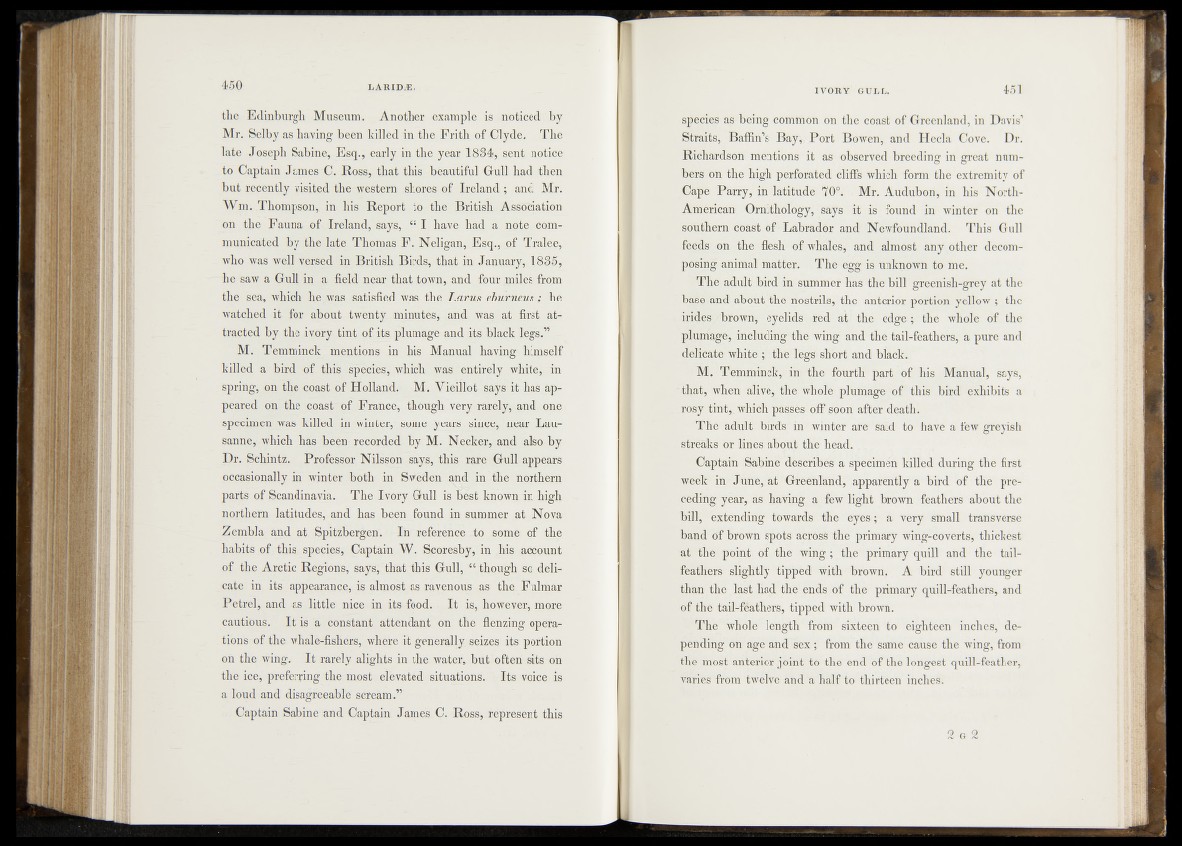
the Edinburgh Museum. Another example is noticed by
Mr. Selby as having been killed in the Frith of Clyde. The
late Joseph Sabine, Esq., early in the year T 884, sent notice
to Captain James C. Ross, that this beautiful Gulfhaii; then
but recently visited the westerfi shores Ireland ; and Mr.
Wm. Thompson, in his Report to the British Association
on the Fauna of .Ireland, says, I have* had a uote communicated
by the late Thomas F . Neligan, Esq., of Trale|||
■who was well versed in British Birds, that in January, 18^5,
die saw a Gull in a field near that town, and, four miles from
the sea, which he was satisfied was the Larus eburncus; he
watched 4t for about twentyiminutes, -and was. at first attracted
by the ivory tint of its plumage and its black legs.”
M. Temminck mentions in his Manual, having hiipself
killed a bird of this species, which was entfrelyy white,, in
spring, on the coast of Holland. M. Vieillbt says it has appeared
on the coastrof ^France, though .very rarely, and one
specimen was killed in winter,“ some,;,years sinec^'hiear Lausanne,
which has been; recorded by M. Necker, and ulso^by
Dr. Schintz. Professor Nilsson says, this rare Gull appears
occasionally in winter both in Sweden and in thel Northern
parts of Scandinavia. The Ivory Gull is best known in high
northern latitudes, and has been found in summer ,at, Nova
Zembla and at Spitzbergen. In' reference J,o some ,of $hje
habits of this, species* Captain W. Scoresby, in ,his account
of the Arctic Regions, says; that this Gull, ^‘ though so delicate
in its appearance, ih almost, as ravenous as the Fulmar
Petrel^ and as little nice in its food. It is, however, more
cautious. It is a constant attendant on the flenzing operations
of the whale-fishers, where it generally; seizes its portion
oh the wing. I t rarely alights in the water, blit often sits oh
the ice, preferring the most elevated situations. Its voiceTs
a loud and disagreeable scream.”
Captain Sabine and Captain James C. Ross, represent this
species as being common on the coast of Greenland, in Davis’
Straits, Baffiii’s Bay^yPort Bowen, and Hecla Cove. Dr.
Richardson mentions it as. observed breeding in great numbers'
On l ie high perforated cliffs which form the extremity of
Cajpe Parry, in latitude. 709. Mr. Audubon, in his North-
Aiherican 'CJrni'thology^says it is found in winter on the
southern coast of'Labrador and Newfoundland. This Gull
feedsMi the ;flesh' of whales',' and almost any .other decomposing
anirfe! matter. The egg is-unknown to me.
The adutl#$lmd in summer lias the bill greenish-grey at the
base am S pw t thc^nos'trils,' the anterior portion yellow ; the
ulifles /brown,|?e^elids red at f.tl|©"Vedge.; the whole of the
'pJMmage, including^the wing and1 the tail-feathers, a pure and
delicate: white ; the legS* short and black..
M T e rnm in ck;^in lthe fourth part of his Manual, says,
q|fat, when alive,'the Wh(M plumage of this bird exhibits a
tint,. whieffiC^ipes off spon after death.
The adult, birds' in r winter are *said to have a few greyish
^freaks (^^hms^^about. the h e a d |^
Captain Sabine describes a specimen killed during the first
.Wdbk in June/'at GreenMfd, apparently a bird of the preceding
year, as having a few light brown feathers about the
bill, extending ^towards . the'^eyus-'l^ a very small transverse
band of brown spots across’ the primary wing-coverts, thickest
at the point of the wing; f the primary quill and the tail-
feathers sightly tipped with brown, A bird still younger
than the i last had the ends of the primary quill-feathers, and
of the tail-feathers, tipped with brown.
• The whole-length from sixteen to eighteen inches, depending
dh age and sex; from the same cause the wing, from
the most anterior :j6'int’to the end of the longest quill-feather,
varies from tweffe and a half to thirteen inches.
2 g 2